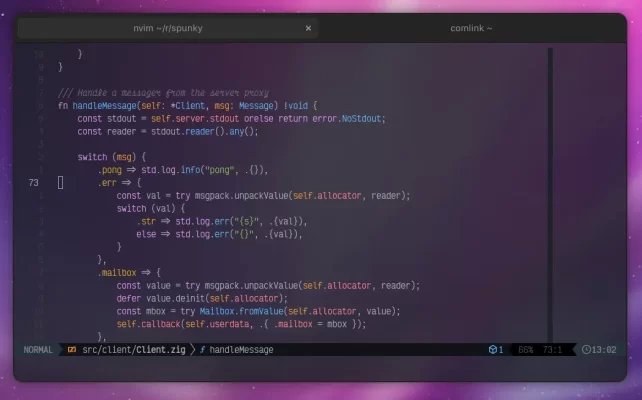-
United Kingdom+44 (20) 4577-20-00
-
USA+1 (929) 431-18-18
-
Israel+972 (55) 507-70-81
-
Brazil+55 (61) 3772-18-88
-
Canada+1 (416) 850-13-33
-
Czech Republic+420 (736) 353-668
-
Estonia+372 (53) 683-380
-
Greece+30 (800) 000-02-04
-
Ireland+353 (1) 699-43-88
-
Iceland+354 (53) 952-99
-
Lithuania+370 (700) 660-08
-
Netherlands+31 (970) 1027-77-87
-
Portugal+351 (800) 180-09-04
-
Romania+40 (376) 300-641
-
Sweden+46 (79) 008-11-99
-
Slovakia+421 (2) 333-004-23
-
Switzerland+41 (22) 508-77-76
-
Moldova+373 (699) 33-1-22
 English
English
Review of the Ghostty Terminal Application
- Main
- Knowledge base
- Review of the Ghostty Terminal Application
Ghostty is a new open-source, cross-platform terminal application developed by Mitchell Hashimoto (co-founder of HashiCorp). The developer explained that his goal was to create a terminal emulator that is fast, feature-rich, and has a native interface while remaining cross-platform. This article provides an overview of the app’s key features and guides you on how to install it on Ubuntu.
Features of the Ghostty Terminal
Ghostty 1.0 is the first stable release following several months of closed beta testing. Even at this early stage, the terminal demonstrates high performance and an extensive feature set.
One of Ghostty’s standout features is its platform-native interface. Unlike other cross-platform terminal tools like Warp or built-in IDE consoles, which often rely on custom or web-based interfaces, Ghostty maintains true native design.
-
On Linux, the Ghostty interface is written in Zig and uses GTK4/libadwaita (on macOS, it’s built with Swift and SwiftUI). This ensures that the interface is not just visually native but truly integrates into the platform, offering native windows, tabs, menus, icons, system fonts, and more. As a result, Ghostty feels like an organic part of the operating system.
- The main challenge in describing a terminal lies in the fact that most of its features are "invisible" to the user, as they relate to command execution and process interaction rather than visual elements. However, Ghostty impresses in this regard too: it resembles GNOME Terminal and could potentially replace it.
Additional features of Ghostty include
-
Support for multiple windows, tabs, and split panes
-
Hardware GPU rendering (OpenGL on Linux, Metal on macOS)
-
A wide variety of themes
-
Native shell integration (bash, zsh, fish, elvish)
-
Convenient system-wide hotkeys
-
Compatibility with xterm
-
Support for ligature and variable-width fonts
-
Enhanced grapheme handling and compatibility with Kitty Graphics Protocol
-
Comprehensive prompt updates when resizing the window
Ghostty is ready to use out of the box, requiring no initial setup, unlike some alternatives. However, users can customize parameters and keybindings by editing a configuration file.
Installing Ghostty on Ubuntu
If you want to try Ghostty, macOS users can simply download the precompiled binary from the official website. On Linux, the installation process is a bit more involved.
Available Installation Methods:
-
A package for Arch Linux (available in the Extra repository)
-
A Nix flake for multi-package environments
-
A Fedora COPR repository (community-supported)
-
An unofficial DEB package for Ubuntu (not yet included in the main repositories)
Building Ghostty from Source on Ubuntu
Download the source code from GitHub and extract the archive.
Install dependencies:
sudo apt install libgtk-4-dev libadwaita-1-devInstall Zig version 0.13 (available via Snap):
sudo snap install --beta zig --classicCompile and install Ghostty:
zig build -p $HOME/.local -Doptimize=ReleaseFast If the app shortcut does not appear after installation, run:
sudo update-desktop-databaseAlternatively, install Ghostty globally:
sudo zig build -p /usr -Doptimize=ReleaseFastConclusion
Ghostty is a promising terminal application with a focus on speed, functionality, and native interface design. If you decide to give it a try, share your experience!







































